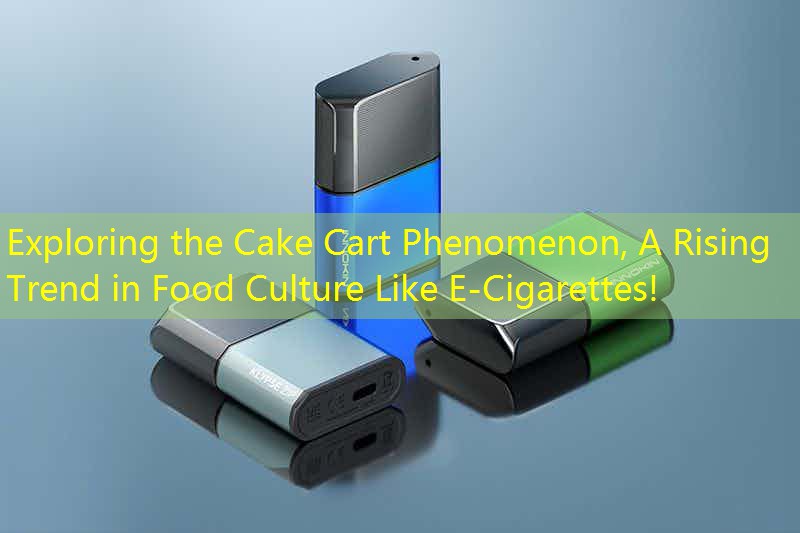Introduction: The Rise of the Cake Cart Phenomenon
In recent years, food culture has undergone a significant transformation, with innovative concepts capturing the attention of culinary enthusiasts and entrepreneurs alike. One such concept that has garnered considerable interest is the phenomenon of the “cake cart.” These portable dessert stations, often seen at outdoor events, markets, and festivals, offer a unique twist on traditional cake sales. With their vibrant displays and irresistible aromas, cake carts have become a staple of contemporary food scenes, bringing a new level of accessibility and creativity to confectionary delights. This article delves into the evolution, management, and impact of cake carts in today’s dessert landscape, while also exploring their parallels to the electronic cigarette market, an industry that has also experienced remarkable growth and change.
The Concept of Cake Carts
Cake carts are mobile vendors showcasing an array of cakes and pastries. They often feature beautiful designs and an assortment of flavors, aiming to attract customers on the go. Designed for both convenience and appeal, they operate as both a culinary experience and a social gathering point. The aesthetics of cake carts are crafted to appeal to the eyes and taste buds, much like the packaging of electronic cigarettes, which are often marketed with sleek designs and vibrant colors to appeal to a variety of consumers.
The emergence of cake carts can be traced back to the growing trend of street food culture. People are drawn to the charm of freshly made desserts served from colorful carts, reminiscent of street vendors in cities around the world. Key factors contributing to the popularity of cake carts include their mobility, the ability to offer unique flavors, and their capacity to create an inviting atmosphere. Furthermore, the cake cart model allows entrepreneurs to start small with lower initial investment costs compared to traditional brick-and-mortar bakery establishments.
The Business Model of Cake Carts
Operating a cake cart involves understanding the logistics of mobile vending. Entrepreneurs often face challenges such as location selection, licensing, and menu development. However, the operational flexibility of a cake cart provides an advantage over a traditional storefront, allowing owners to gauge consumer interest and adjust their offerings accordingly.
Here is an illustrative comparison of investment and operating costs between a cake cart and a traditional bakery:
| Item | Cake Cart | Traditional Bakery |
|---|---|---|
| Initial Investment | $5,000 – $20,000 | $50,000 – $200,000 |
| Monthly Operating Costs | $1,000 – $3,000 | $5,000 – $15,000 |
| Employee Count | 1 – 3 | 5 – 20 |
As evident from the data, the financial barrier to entry for a cake cart is significantly lower, enabling aspiring bakers to venture into entrepreneurship more easily. Moreover, the mobile nature of a cake cart allows for strategic positioning at high-traffic events, maximizing potential sales.
The Flavor Revolution
One of the most exciting aspects of cake carts is the diverse range of flavors they offer. Unlike traditional bakeries, which may adhere to classic recipes, cake carts have the freedom to experiment with bold and unconventional flavor combinations. From floral-infused cakes to fusion desserts that incorporate elements from different cultures, the menu of a cake cart reflects current gastronomic trends and consumer desires for novelty and creativity.
This trend parallels the development of electronic cigarettes, where flavor innovation plays a crucial role in attracting customers. Vape shops frequently introduce unique flavor profiles, catering to an audience that craves variety. Both cake carts and e-cigarettes have tapped into consumer preferences for experimentation and personalization, making them appealing options in the crowded market of food and beverage.
Design Matters: The Visual Appeal of Cake Carts
The design of a cake cart greatly influences customer engagement. A well-designed cart can be a powerful marketing tool that not only showcases the cakes but also provides an enjoyable aesthetic experience for customers. Attention to detail, from the color scheme to the presentation of desserts, can create a memorable visual impact that attracts passersby.
Similarly, the aesthetic appeal of electronic cigarette branding is crucial for market success. Sleek designs and eye-catching colors can draw in potential buyers, enhancing the overall consumer experience. Case studies from both industries reveal that strong branding and design elements can significantly boost customer loyalty and sales.
The Impact on Local Communities
Cake carts have begun to thrive within local communities, where they provide not only delicious treats but also a sense of community and local culture. By participating in local events, farmers’ markets, and festivals, cake cart vendors foster social connections and support local economies. They often collaborate with local producers for ingredients, adding a layer of authenticity to their offerings.
In much the same way, electronic cigarette vendors often engage with local communities through educational workshops, promoting responsible vaping practices. Both industries recognize the importance of community connections, which leads to sustainable success and better customer relationships.
Challenges Faced by Cake Cart Entrepreneurs
Despite their growing popularity, cake carts are not without challenges. Vendors must navigate local health regulations and maintain food safety standards, which can be daunting for newcomers. Weather conditions can also pose logistical hurdles, impacting sales and operational capabilities.
Additionally, the competitive landscape is continually evolving, with new vendors entering the market. To stand out, cake cart owners must develop a unique selling proposition, whether it be through innovative flavors, exceptional customer service, or a commitment to sustainability.
The Future of Cake Carts
The future of the cake cart industry looks promising, as consumer preferences continue to lean toward convenience and unique food experiences. With the rise of social media, cake carts can leverage platforms like Instagram and TikTok to showcase their offerings, reaching broader audiences and cultivating loyal customer bases.
Innovations in technology may also play a role in this evolution. For example, mobile payment systems can streamline transactions, while data analytics can help vendors better understand sales trends and customer preferences.
Questions and Answers
What are the main advantages of operating a cake cart over a traditional bakery?
The primary advantages include lower initial investment and operating costs, increased flexibility in location, and the opportunity for flavor experimentation. With a cake cart, entrepreneurs can quickly adapt to consumer preferences and trends.
How do cake carts contribute to local economies?
Cake carts encourage local entrepreneurship, create job opportunities, and support other local businesses by sourcing ingredients from nearby producers. Their presence in community events fosters a sense of belonging and engagement among residents.
What challenges should new cake cart owners be aware of?
New cake cart owners should be prepared for regulatory compliance, food safety standards, and competition. They should also consider weather impacts on sales and have contingency plans in place to address these challenges.








